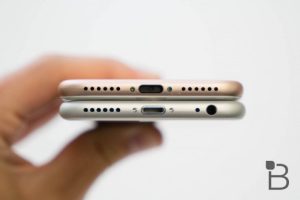Hit the Road, Jack
November 16, 2016
Yeah, I know, you can’t use your $100+ wired headphones anymore without using that stupid dongle. I feel your pain, but why, in the year 2016, in a world of wireless internet, wireless phones, and even such obscurities as wireless refrigerators, are we still using a technology that was invented in the late 1800s designed for the telegraph?
Greg Joswiak, a VP at Apple, said “[The headphone jack] had its last big innovation about 50 years ago. You know what that was? They made it smaller. It’s a dinosaur. It’s time to move on.” Aside from this reason, let’s see why it’s a good thing Apple got rid of this port.
The biggest reason lies in real estate. iPhones keep getting thinner (Though some might argue larger overall. I’m looking at you, iPhone 7 Plus users). Because of this, it’s hard to compress an entire computer into something phone-sized. The battery takes up the majority of the room in most smartphones, and for good reason. Bigger batteries mean better battery life, which the new iPhone has. That extra capacity, combined with the more efficient software, iOS 10, provides one to two hours of extra battery for each phone compared to their predecessors.
Besides the larger battery, what fills up the space where the headphone jack used to be? Don’t be fooled by that speaker grille, because that’s just for show. There’s a major component in that area that Apple calls the “Taptic Engine”, and it’s what makes your phone vibrate. Why did they move it from where it was before? Because it simulates the click of the home button now.
Hold up… There’s no real home button now? That’s right, the new “button” is pressure sensitive. You might be wondering “Why would Apple do this? The home button is an integral feature of the iPhone!” (heads up: there may be NO home button on next year’s device). There is a purpose for these changes, and that takes us to our second reason for the removal of the headphone jack: waterproofing.
The upside to all of this is that you can take the iPhone underwater with you now — without a case. This is why the home button is simulated, and why there is no headphone jack. Apple has rated the iPhone 7 as IP67 water-resistant, which basically means you can take it up to one meter underwater for up to half an hour.
However, like they usually do, Apple has seriously underrated the power of the new iPhone, as in multiple test videos it has beaten the Samsung Galaxy S7, which has a stronger waterproof rating, in all underwater tests, including maximum depth and duration. Sorry Samsung fans, your phones have been bested again (both in waterproofing and the tendency to not explode).
My final reason why the removal of the AUX is beneficial: The future will be wireless. This is Apple’s main reason too. Even charging will eventually be wireless. It’s a rumored feature for next year’s tenth anniversary iPhone, and Apple already has the patents necessary for wireless charging. Yes, many Androids have had wireless chargers for years, but Apple’s version will be truly wireless. No cords, and no charging pads.
My personal opinion: there won’t be a single port or button on the iPhone in a few years. That may seem ridiculous, but that’s what Apple has wanted all along: a technological masterpiece disguised as a single sheet of glass. All these ports, jacks, and buttons just get in the way. Many people are saying that the iPhone 7 is a transitional device, or a prototype even, designed to get the public used to the idea of Apple’s singularly wireless future, which will most likely begin with next year’s device. I think they’re right, and I’m looking forward to that future. You should too.
So, if you’re in need of a new phone that can go underwater, survive massive drops, and won’t explode at random, go with the iPhone 7. And let’s not continue to mourn the headphone jack. Let’s do it all at once. We’ll remove our hats, and listen to Taps. On our wireless earphones of course.








